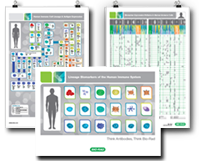Innate Lymphoid Cell Markers and Subsets

- On This Page
- ILC Subsets
- ILC1
- ILC2
- IL3
- Innate lymphoid cells markers
- References
Subsets
Innate lymphoid cells (ILCs) form part of the innate immune system. Recently discovered, their role in infection, inflammation and disease are only now starting to emerge.
The ILC family not only includes the three different subsets of the noncytotoxic ILCs (ILC1, ILC2 and ILC3 (Spits et al. 2013)) but also includes Natural Killer cells (refer to our NK cells mini-review) and Lymphoid Tissue Inducer (LTi) cells. This family of innate cells can be characterized by their classical lymphoid cell morphology along with two distinguishing features:
- They do not express the major surface molecules that recognize other immune cell types, such as CD3, CD19, CD56, CD68 and CD205; designated as cell lineage marker negative (Lin-) (Spits et al. 2013)
- They do not have any antigen specificity for the recognition of pathogens (Spits and Santo 2011)
Although ILCs and LTi cells are derived from a common lymphoid progenitor and subsequent downstream α-lymphoid progenitors and early innate lymphoid progenitors, the same as NK cells, these noncytotoxic cells then follow a separate developmental path (Klose et al. 2014). During the stages of development different surface antigens are expressed, enabling detection of these specific cells. Refer to our ILC mini-review for further information on ILC lineage of both humans and mice alongside key markers for the different stages of development.
The three different ILC subsets can be defined according to the immunological effect they confer and the molecules they secrete:
ILC1 |
|
|---|---|
|
Immunity |
Intracellular bacteria and parasites |
|
Secrete |
Interferon γ and tumor necrosis factor (TNF) |
ILC2 |
|
|---|---|
|
Immunity |
Helminths, allergic inflammation and tissue repair |
|
Secrete |
Interleukin (IL)-4, IL-5, IL-9, IL-13 and epidermal growth factor receptor ligand amphiregulin |
ILC3 |
|
|---|---|
|
Immunity |
Bacteria, chronic inflammation and tissue repair |
|
Secrete |
IL-17A, IL-17F, IL-22, granulocyte macrophage colony stimulating factor and TNF |
Data taken from Artis and Spits 2015.
Further information on the characterization of ILC subsets and their role in pathogen defence, disease and immunotherapy can be found in our ILC mini-review.
Innate Lymphoid Cells Markers
The various subsets of ILCs can be identified according to the markers they express; this is also true when looking to determine ILCs at various points of their maturation process. The table below lists some of the key markers in the identification of the ILC subsets. To discover the antibodies available to these markers, simply click on the marker. Detailed information on ILC marker expression can be found in our mini-review of innate lymphoid cells. Search for your ILC antibody of choice by using the search box at the top of the page.
ILC Subset |
Human Markers |
Murine Markers |
|---|---|---|
|
ILC1 |
||
|
ILC2 |
||
|
ILC3 – NCR- |
||
|
ILC3 – NCR+ |
Marker expression of ILC subsets.
References
- Artis D and Spits H (2015). The biology of innate lymphoid cells. Nature 517, 293-301.
- Klose CSN et al. (2014). Differentiation of type 1 ILCs from a common progenitor to all helper-like innate lymphoid lineages. Cell 157, 340-356.
- Spits H et al. (2013). Innate lymphoid cells - a proposal for uniform nomenclature. Nat Rev Immunol 13, 145-149.
- Spits H and Di Santo JP (2011). The expanding family of innate lymphoid cells: regulators and effectors of immunity in tissue remodeling. Nat Immunol 12, 21-27.



